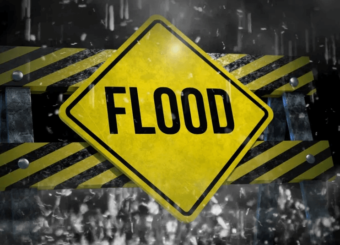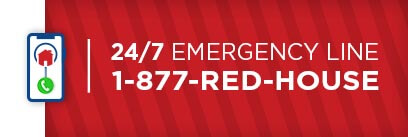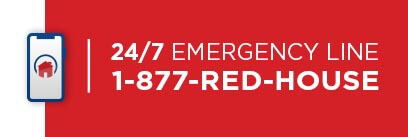
Last Updated: March 1, 2023
It’s Flood Safety Awareness Month! Flooding accounts for 90% of all natural disasters in the U.S., and can cause more damage than any other weather-related or storm event. Nearly every day, flooding happens somewhere in the country. It’s important to be aware of what to do before, during and after a flood!
Flooding is the most common natural disaster in Pennsylvania and the most frequent natural hazard in New Jersey, destroying thousands of homes and businesses and costing billions of dollars each year. Only 3% of Virginians have flood insurance, although Virginia officials estimate that 1 inch of water in a home can cause upwards of $25,000 in damages. According to Maryland officials, there is no such thing as a “flood proof” area; any area can flood, even high ground.
According to the NOAA, flooding is one of the most damaging types of natural disasters in the U.S.. NOAA’s recent analysis of major disasters since 1980 found that inland flooding accounted for $150 billion in damage during major disasters.
It’s important to be prepared, no matter where you live.
FLOOD PREPAREDNESS
1. Know Your Risk
Find out whether your home and/or business is in a flood-prone or high-risk area with FEMA’s Flood Map Service Center. Last June, the first-ever public evaluation of flood risk by First Street Foundation, a research and technology nonprofit, found that that federal maps underestimate the number of homes and businesses in significant flood danger by 67%. You can also get a second opinion and find out your flood risk score at www.FloodFactor.com.
2. Create A Plan
Ensure that you have an evacuation and emergency readiness plan and communicate it with family, friends, staff and your business associates. Check out FEMA’s Family Communication Plan and the FEMA Business Plan.
3. Business Continuity Plan
If you’re a business owner, it’s important that your company is prepared and ready with a plan to communicate, streamline operations and manage workflow in the event of a major storm or weather event. More than 40% of businesses never reopen after a disaster, 25% will close after a year, and 75% without a business continuity plan will fail, according to the Federal Emergency Management Agency (FEMA). Don’t be a statistic!
4. Get Flood Insurance
If it can rain, it can flood. Just a few inches of water from a flood can cause tens of thousands of dollars in damage. Standard insurance policies do not cover flooding. Flood coverage is provided by the federal government’s National Flood Insurance Program. Flood insurance takes 30 days to take effect, so it’s important to have it before you need it.
5. Gather Emergency Supplies
Create an emergency kit including battery or solar-operated radio, flashlights, extra batteries, first aid kit, food and water, cash and credit cards, medications, and pet supplies. Check out FEMA’s recommended supplies checklist.
6. Know the Difference Between a Flash Flood Warning and a Flash Flood Watch
A Flash Flood Warning occurs when flooding is currently happening or is going to happen soon. Take immediate action! A Flash Flood Watch happens when a flood is possible. It’s important to follow news from your local weather apps, stations and local officials.

7. Protect Your Home and/or Business
Know where your valves are if you need to turn off gas, water and electricity. Disconnect appliances and equipment. Store valuables and important documents in a waterproof safe. If you live in an area that has a high flood risk, elevate the water heater, furnace and electric panel. Seal basement walls with waterproofing compounds. As a preventative measure, you may want to install “check valves” to mitigate flood water from backing up into your drains. You can also use stoppers or large corks as a last resort to plug tubs and showers.
8. Evacuate If Necessary
If you need to leave, do so well in advance. It takes six inches of fast-moving flood water to sweep an adult off of their feet. Just 12-18 inches can sweep away most vehicles in floodwaters. Avoid driving or walking across flooded roads if there’s heavy rains. According to the Centers for Disease Control and Prevention, the most common flood deaths occur when a vehicle is driven into hazardous floodwater. Turn Around, Don’t Drown!

9. Stay Informed
Follow updates your local officials. Visit Ready.Gov Alerts and check out local weather updates and alerts. The FEMA app includes safety tips and alerts.
10. After the Flood
- When it’s safe and cleared by local officials and emergency management personnel, you can return to assess. Make sure the power is off. Remember, floodwaters can contain harmful bacteria and contaminants. Wear protective gear including gloves, masks and waterproof boots.
- Before you cleanup, take photos and/or video footage of your property, as well as your belongings. This will help support your insurance claim.
- Get in touch with a licensed restoration contractor to professionally manage the cleanup. This is essential to ensure dry-out and water removal processes are performed to industry standards, protect your property, and to prevent further damage and mold.
- Contact your insurance agent to get started with your insurance claim.
About Home Repair, LLC
With over 30 years of experience, Home Repair LLC is a licensed general contractor providing water and storm damage restoration services throughout Maryland, New Jersey, Pennsylvania, and Virginia. Our mission is to help you get your property restored better than before. We provide the highest level of expertise, integrity, value, and service every step of the way.
RESOURCES
- CDC: Flood Safety Tips
- FEMA: Flood Map Service Center
- FEMA: National Flood Insurance Program
- FEMA: Flood Insurance
- FEMA App
- FEMA: Family Communication Plan
- Insurance Information Institute: In Case Of A Flood
- Ready.Gov: Emergency Supply Kit Checklist
- Maryland Emergency Management Agency: Floods
- Ready.PA.Gov: Home Emergency Kit
- Ready.PA.Gov: Know The Threats: Flooding
- DCR: Virginia Flood Risk Information System
- DCR: Virginia Flood Awareness
- States At Risk: New Jersey Coastal Flooding
- NJ Flood Mapper
- Ready.NJ.Gov: Floods & Flash Floods
- Ready.Gov:Business
- Ready.Gov: Emergency Preparedness Kit
- Ready.Gov Phone Alerts




